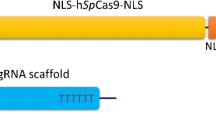Abstract
Skeletal muscle is the major component of lean tissue that is used for consumption, and myostatin is a negative regulator of skeletal muscle growth. Downregulation of this gene therefore offers a strategy for developing superior animals with enhanced muscle growth. Knockdown of myostatin was achieved by RNA interference technology. The anti-myostatin shRNA were designed and stably transfected in caprine fibroblast cells. The reduced expression of target gene was achieved and measured in clonal fibroblast cells by real-time PCR. Two single-cell clones induced significant decrease of myostatin gene expression by 73.96 and 72.66 %, respectively (P < 0.05). To ensure the appropriate growth of transfected cell, seven media were tested. The best suited media was used for transfected fibroblast cell proliferation. The findings suggest that shRNA provides a novel potential tool for gene knockdown and these stably transfected cells can be used as the donor cells for animal cloning.



Similar content being viewed by others
References
Conlon, I., & Raff, M. (1999). Size control in animal development. Cell, 96, 235–244.
Langley, B., Thomas, M., Bishop, A., Sharma, M., Gilmour, S., & Kambadur, R. (2002). Myostatin inhibits myoblast differentiation by down-regulating myod expression. The Journal of Biological Chemistry, 277, 49831–49840.
McPherron, A. C., & Lee, S. J. (1997). Double muscling in cattle due to mutations in the myostatin gene. Proceedings of the National Academy of Sciences, 94(23), 12457–12461.
Grobet, L., Poncelet, D., Royo, L. J., Brouwers, B., Pirottin, D., Michaux, C., Me’nissier, F., Zanotti, M., Dunner, S., & Georges, M. (1998). Molecular definition of an allelic series of mutations disrupting the myostatin function and causing double-muscling in cattle. Mammalian Genome, 9, 210–213.
Agrawal, N., Dasaradhi, P. V. N., Mohmmed, A., Malhotra, P., Bhatnagar, R. K., & Mukherjee, S. K. (2003). RNA interference: biology, mechanism, and applications. Microbiology and Molecular Biology Reviews, 67(4), 657–685.
Stewart, C. K., Li, J., & Golovan, S. P. (2008). Adverse effects induced by short hairpin RNA expression in porcine fetal fibroblasts. Biochemical and Biophysical Research Communications, 370(1), 113–117.
Jain, H., Singh, S., Kadam, M., & Sarkhel, B. C. (2010). Knockdown of the myostatin gene by RNA interference in caprine fibroblast cells. Journal of Biotechnology, 145(2), 99–102.
Singh, N. K., Singh, S., Jain, S. K., & Sarkhel, B. C. (2012). Evaluation of interferon response induced by anti-myostatin shRNA constructs in goat (Capra hircus) fetal fibroblasts by quantitative real time-polymerase chain reaction. Animal Biotechnology, 23(3), 174–183.
Boquest, A. C., Grupen, C. G., Harrison, S. J., McIlfatrick, S. M., Ashman, R. J., d’Apice, A. J., & Nottle, M. B. (2002). Production of cloned pigs from cultured fetal fibroblast cells. Biology of Reproduction, 66, 1283–1287.
Sharma, A., Naziruddin, B., Cui, C., Martin, M. J., Xu, H., Wan, H., Lei, Y., Harrison, C., Yin, J., Okabe, J., Mathews, C., Stark, A., Adams, C. S., Houtz, J., Wiseman, B. S., Byrne, G. W., & Logan, J. S. (2003). Pig cells that lack the gene for alpha1-3 galactosyltransferase express low levels of the gal antigen. Transplantation, 75, 430–436.
Takeda, K., Tasai, M., Iwamoto, M., Akita, T., Tagami, T., Nirasawa, K., Hanada, H., & Onishi, A. (2006). Transmission of mitochondrial DNA in pigs and progeny derived from nuclear transfer of Meishan pig fibroblast cells. Molecular Reproduction and Development, 73, 306–312.
Freshney, R. I. (2005). Culture of animal cells: a manual of basic technique. New York:Wiley-Liss.
Daniel, S. M., Raipuria, P., & Sarkhel, B. C. (2008). Efficiency of cloned embryo production using different types of cell donor and electric fusion strengths in goats. Small Ruminant Research, 77, 45–50.
Livak, K. J., & Schmittgen, T. D. (2001). Analysis of relative gene expression data using real time quantification PCR and the 2 -ΔΔct method. Methods, 25, 402–408.
Elbashir, S. M., Harborth, J., Lendeckel, W., Yalcin, A., Weber, K., & Tuschl, T. (2001). Duplexes of 21-nucleotide RNAs mediate RNA interference in cultured mammalian cells. Nature, 411, 494–498.
Kaltenbach, J. P., Kaltenbach, M. H., & Lyons, W. B. (1958). Nigrosin as a dye for differentiating live and dead ascites cell. Experimental Cell Research, 15, 112–117.
Kung, M., Stadelmann, B., Brodbeck, U., & Butikofer, P. (1997). Addition of G418 and other aminoglycoside antibiotics to mammalian cells results in the release of GPI-anchored proteins. FEBS Letters, 409(3), 333–338.
Zou, X., Wang, Y., Chang, Y., Yang, Y., et al. (2002). Generation of cloned goat from transfected foetal fibroblast cells, the effect of donor cell cycle. Molecular Reproduction and Development, 61(2), 164–172.
Melo, E.O., Sousa, R.V., Iguma, L.T., Franco, M.M., Rech, E.L., & Rumpf, R. (2005). Isolation of transfected fibroblast clones for use in nuclear transfer and transgene detection in cattle embryos. Genetics and Molecular Research, 4(4), 812–821.
Yu, J. N., Ma, S. F., Miao, D. Q., Tan, X. W., Liu, X. Y., Lu, J. H., & Tan, J. H. (2006). Effect of cell cycle status on the efficiency of liposome mediated gene transfection in mouse fetal fibroblasts. Journal of Reproduction and Development, 52(3), 373–382.
Acknowledgments
The authors are thankful to National Agriculture Innovation Project, Indian council of Agricultural Research, Government of India, New Delhi, for the financial support.
Conflict of Interest
The authors declare that they have no competing interests.
Compliance with Ethical Standards
This is to state that this entire research work does not involve any human or animal.
Author information
Authors and Affiliations
Corresponding author
Rights and permissions
About this article
Cite this article
Jain, S.K., Jain, H., Kumar, D. et al. Quantitative Evaluation of Myostatin Gene in Stably Transfected Caprine Fibroblast Cells by Anti-Myostatin shRNA. Appl Biochem Biotechnol 177, 486–497 (2015). https://doi.org/10.1007/s12010-015-1757-1
Received:
Accepted:
Published:
Issue Date:
DOI: https://doi.org/10.1007/s12010-015-1757-1




